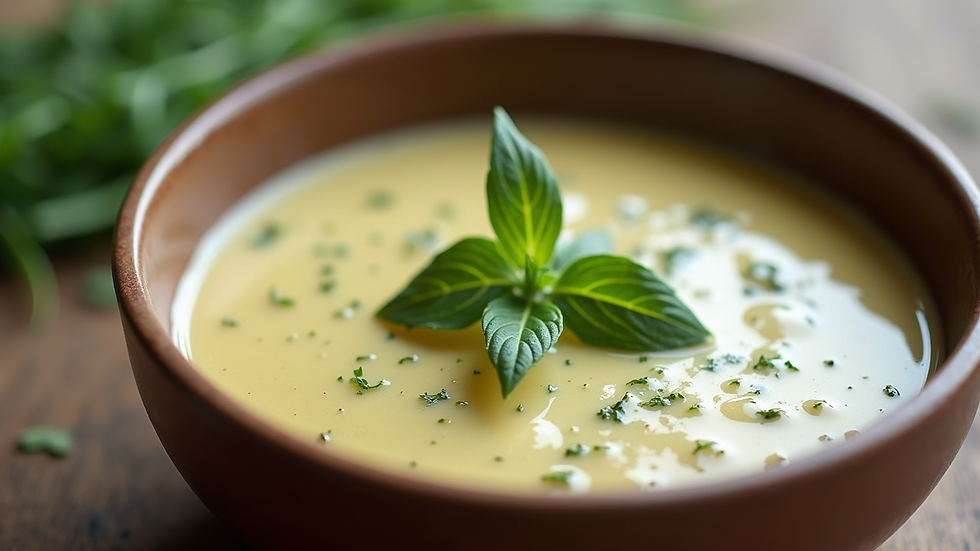Master the Art of Homemade Salad Dressings
- Thibaut Laourou
- Oct 20
- 4 min read
Salad dressings can transform a simple bowl of greens into a vibrant, flavourful meal. Making your own dressings at home is not only healthier but also allows you to customise flavours to suit your taste. Whether you prefer tangy, creamy, or sweet dressings, mastering the art of homemade salad dressings is easier than you think. This guide will walk you through the essentials, from basic formulas to creative recipes, helping you elevate your salads every time.
Why Choose Homemade Salad Dressings?
Store-bought dressings often contain preservatives, added sugars, and artificial flavours. By making your own, you control the ingredients and avoid unnecessary additives. Homemade dressings are fresher, more nutritious, and can be tailored to dietary needs such as gluten-free, vegan, or low-fat options.
Additionally, creating your own dressings allows you to experiment with different oils, vinegars, herbs, and spices. This flexibility means you can complement any salad, from a simple green mix to a hearty grain bowl.
Benefits of homemade salad dressings:
Fresh ingredients with no preservatives
Customisable flavours and textures
Healthier options with less sugar and salt
Cost-effective compared to premium store brands
Fun and creative cooking experience

Exploring Popular Types of Homemade Salad Dressings
There are countless salad dressing styles, but some classics stand out for their versatility and ease of preparation. Here are a few popular types you can try at home:
Vinaigrettes
A vinaigrette is a simple emulsion of oil and vinegar, often enhanced with mustard, herbs, and seasonings. It’s light and tangy, perfect for green salads or roasted vegetables.
Basic vinaigrette ingredients:
3 parts oil (peanut oil, olive oil, or avocado oil)
1 part vinegar (balsamic, red wine, apple cider)
Salt and pepper to taste
Optional: Dijon mustard, honey, garlic, fresh herbs
Creamy Dressings
Creamy dressings use bases like yoghurt, mayonnaise, or buttermilk to create a rich texture. They pair well with crunchy salads or as dips.
Popular creamy dressings:
Caesar dressing with anchovies and Parmesan
Ranch with herbs and garlic
Blue cheese with crumbled cheese and sour cream
Sweet and Tangy Dressings
These dressings balance acidity with sweetness, often using ingredients like honey, maple syrup, or fruit juices. They are excellent for salads with bitter greens or spicy elements.
Example ingredients:
Citrus juice (orange, lemon)
Honey or agave syrup
Olive oil or uppernut cold pressed peanut oil
Mustard or ginger for a kick

What is the basic salad dressing formula?
Understanding the basic formula for salad dressings is key to mastering homemade versions. Most dressings follow a simple ratio that balances acidity and fat, creating a harmonious flavour.
The classic formula:
3 parts oil to 1 part acid
This means for every tablespoon of vinegar or lemon juice, you use three tablespoons of oil. This ratio can be adjusted depending on your taste preference or the type of salad.
How to emulsify
To combine oil and vinegar smoothly, whisk them vigorously or shake in a jar with a tight lid. Adding an emulsifier like mustard or honey helps keep the dressing from separating.
Seasoning and flavouring
Salt enhances the overall taste, while pepper adds a mild heat. Fresh or dried herbs, garlic, shallots, and spices can be added to create unique profiles.
Tips for perfect dressings
Use good quality oils and vinegars for the best flavour.
Taste and adjust seasoning gradually.
Store dressings in the fridge and shake before use.
Experiment with different acid types like sherry vinegar or lime juice.

Step-by-step guide: How to make dressing at home
Making your own salad dressing is quick and satisfying. Here’s a simple step-by-step guide to get you started:
Choose your base: Select an oil and an acid (vinegar or citrus juice).
Measure ingredients: Use the 3:1 oil to acid ratio as a starting point.
Add flavour enhancers: Include mustard, honey, garlic, or herbs.
Combine: Whisk vigorously or shake in a jar until emulsified.
Season: Add salt and pepper to taste.
Taste and adjust: Modify acidity, sweetness, or seasoning as needed.
Serve or store: Use immediately or refrigerate in a sealed container for up to a week.
For more detailed recipes and inspiration on how to make dressing, explore trusted food blogs and cooking sites.
Creative twists to elevate your salad dressings
Once you master the basics, you can experiment with exciting ingredients to create signature dressings. Here are some ideas to inspire your culinary creativity:
Add fresh fruit purée: Blend strawberries, mango, or raspberries for a fruity vinaigrette.
Incorporate nuts or seeds: Toasted sesame seeds or crushed walnuts add texture and flavour.
Use infused oils: Try basil, chili, or garlic-infused oils for a flavour boost.
Try different vinegars: Experiment with sherry, champagne, or rice vinegar.
Add umami: Soy sauce, miso paste, or anchovy paste can deepen the taste.
Make it spicy: Add chilli flakes, horseradish, or wasabi for heat.
These variations can transform your salads and keep your meals exciting and fresh.
Mastering homemade salad dressings is a rewarding skill that enhances your meals and supports a healthier lifestyle. With simple ingredients and a bit of practice, you can create delicious dressings tailored to your preferences. Start with the basics, then explore new flavours and textures to keep your salads vibrant and enjoyable all year round.





Comments